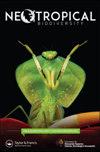Morphoanatomical leaf traits of herbaceous species raised in a cronosequence of naturally regenerated areas of tropical deciduous forest
IF 0.8
Q4 ECOLOGY
引用次数: 0
Abstract
Plant survival in semi-arid climates depends on morphological, anatomical, and physiological adjustments that determine survival under limiting environmental conditions. In this study, anatomical and morphological characteristics of three herbaceous species with different growth habits were determined: a tall herb, Mesosphaerum suaveolens (tall), Stachytarpheta sanguinea (short), and Jacquemontia evolvuloides (climbing). Fully expanded leaves were collected from three sites in each of three different natural regeneration periods in a seasonally dry tropical forest. Leaf, specific leaf area, epidermis, cuticle, parenchyma, and mesophyll thicknesses; stomatal and trichome densities were measured. All three species have stomata and trichomes on both leaf surfaces and higher densities on the abaxial surface than the adaxial surface. M. suaveolens and S. sanguinea have unusual leaf morphological and anatomical adjustments, with a larger leaf area in the more open and youngest site, but thicker abaxial and adaxial epidermis and mesophyll in the oldest site which has the closest canopy stratum. J. evolvuloides has more usual adjustments, with a smaller specific leaf area and thinner epidermis and isobilateral parenchyma in the youngest site, being better acclimatized to low water availability and high light incidence. Therefore, M. suaveolens and S. sanguinea have unique acclimatization strategies for different environmental conditions.热带落叶林自然再生区中生草本植物的形态解剖特征
植物在半干旱气候下的生存取决于形态、解剖和生理上的调整,这些调整决定了在有限环境条件下的生存。本研究对3种生长习性不同的草本植物Mesosphaerum suaveolens(高)、Stachytarpheta sanguinea(短)和Jacquemontia evolvuloides(攀缘)进行了解剖形态学分析。在一个季节性干燥的热带森林中,在三个不同的自然更新期的三个地点收集了完全展开的叶子。叶,比叶面积,表皮,角质层,薄壁组织和叶肉厚度;测定气孔和毛状体密度。这三种植物的叶片表面均有气孔和毛状体,叶片背面的气孔和毛状体密度高于叶片正面。毛茛和血荆的叶片形态和解剖结构有不同寻常的变化,最开阔和最年轻的立地叶片面积较大,而冠层最接近的最老立地叶片的背面和正面表皮和叶肉较厚。长叶松的调节规律更多,最年轻立地的比叶面积更小,表皮和等双侧薄壁更薄,对低水分有效度和高光照射的适应能力更强。因此,suaveolens和S. sanguinees对不同的环境条件具有独特的适应策略。
本文章由计算机程序翻译,如有差异,请以英文原文为准。
求助全文
约1分钟内获得全文
求助全文
来源期刊

Neotropical Biodiversity
Environmental Science-Ecology
CiteScore
1.80
自引率
0.00%
发文量
39
审稿时长
24 weeks
 求助内容:
求助内容: 应助结果提醒方式:
应助结果提醒方式:


